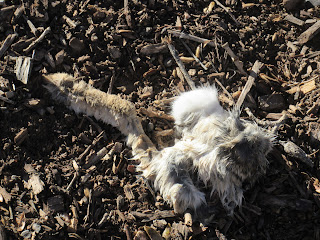just before the snowfall, I was out along the clear ditch. It is pretty amazing how the behaviour of the birds change with the weather. 
A big blue heron was sitting watching the fish below. There were small flocks of dove, flicker, thrush, and wood peckers sitting among the small branching waiting for the weather to change. Amazingly, they were all holding still for the camera. I chose to just watch them at rest, its so rare to actually get to observe them.

The bird feeder was popular with small birds as the wild food sources become harder to reach in the snow. Birds face increased stress at feeders because of the general rowdiness of the regular visitors protecting "their" turf, but when the weather is cold, its more worth it to save time and effort on unpredictable foraging. Unlike most mammals and all reptiles, birds must either eat or migrate with unfavorable weather conditions. Its the same for humans, we do not hibernate in cold weather, even if we think we do. I'm guessing all water sources are freezing up too, as you can almost see the disappointed looks on their beaks as they sidle up to the frozen bird bath.
There are a lot more rabbits around as the young shoots of grass are now only found under fallen leaves and inside low growing bushes, like the russian thistle. To me, rabbits mean the predators are following them, there is not a lot that seems cool about a cottontail, they are just so prevalent. I have heard anecodotes that bobcats are being seen in the area, and am pretty sure this is why there is a rabbit's leg bone below a large tree bough in our neighbour's yard.
I see many rabbits around early in the morning, so I know many of them survived...
This tree should not really be growing in the bosque. It is a juniper (often called "cedar") I think it is a one seed juniper but I am not that into plants. The seeds are tasty to people (in moderation) but are very dry this time of year they are the seasoning added to alcohol to make gin. Coyotes love them, judging by the amount of seeds I see in their scat (poop). These trees, along with the pinon evergreens are usually found in higher elevation in drier conditions. Many of these seedlings are from trees planted by people, but the climate in the Southwest is definitely on a drying trend, and it's likely junipers are going to proliferate in the hotter, drier climate that is coming.





No comments:
Post a Comment